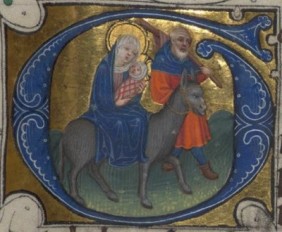
The Flight into Egypt, Walters Art Museum, MS W.188, f.112r
In the early 1990s, I was a graduate student at Yale working on a PhD in Medieval Studies. My dissertation focused on a fragmentology project, although that word would not be coined for decades. Seventeen leaves from a twelfth-century antiphonal from the Austrian Benedictine abbey of Lambach (on the Danube about halfway between Salzburg and Vienna) had made their way to Yale’s Beinecke Rare Book and Manuscript Library, and for my thesis I reconstructed the manuscript as much as possible – adding to the seventeen Yale leaves four leaves still in Lambach, two in the abbey of St-Paul-im-Lavanttal, another that was hanging on the wall of an alpine resort in Badgastein, two at Harvard, and one at the St. Louis Public Library (I’ve blogged about that one here) – and studied the cumulative liturgy, music, and decoration of the manuscript in the context of the twelfth-century Lambach scriptorium. The manuscript is known as the Gottschalk Antiphonary (or Antiphonal), after the scribe/artist Gottschalk of Lambach who was primarily responsible for its creation.
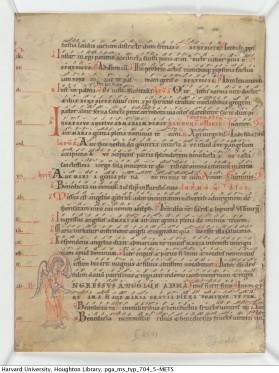
The Gottschalk Antiphonal
The Gottschalk Antiphonal has a very different post-medieval story than the leaves of manuscripts dismembered by Otto Ege about which I have frequently blogged. The Gottschalk Antiphonal was a victim of pre-modern recycling rather than twentieth-century biblioclasm. The manuscript – its music and liturgy hopelessly outdated by the late Middle Ages – was taken apart in the fifteenth century and its leaves were used as flyleaves and pastedowns for incunables bound at the Lambach bindery. These and dozens of other binding fragments were removed from the early bindings and sold to raise money for the Abbey’s woodshop during World War II. Eventually, the collection made its way to New York dealer Hans P. Kraus, and from there to the Beinecke Library at Yale in the 1960s along with hundreds of fragments collectively known as MS 481 and MS 482. By that time, the origin of the Lambach group had been forgotten.
As a graduate student in the 1990s, I had a job working for the Curator of Pre-1600 Books and Manuscripts at the Beinecke and was assigned the task of cataloguing part of Yale’s enormous fragment collection, of which the then-unidentified leaves of the Gottschalk Antiphonal were part. The story of how the curator (Robert G. Babcock), fellow students Philip Rusche and Nancy Seybold, and I discovered the Lambach origin of the Antiphonal and dozens of other leaves has been told elsewhere. The Lambach project was the inspiration for my dissertation and first book and was the beginning of my thirty-year interest in medieval manuscript leaves and fragments.
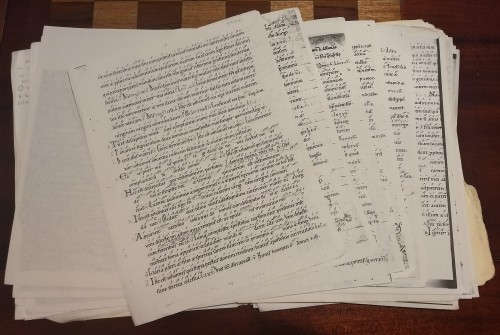
Fragmentology, ca. 1992
Reconstructing the Gottschalk Antiphonal in 1992, sitting on the floor of my living room with scissors and paste and photocopies of the leaves, I was, without realizing it, “doing” fragmentology. Analog was the only option back then, of course. In the early years of the twenty-first century, scholars began to realize the potential of burgeoning digital technologies for the virtual reconstruction of dismembered manuscripts. The call to arms was issued by Barbara Shailor (who was at the time the Director of the Beinecke Library) in a 2003 article, “Otto Ege: His Manuscript Fragment Collection and the Opportunities Presented by Electronic Technology” (The Journal of the Rutgers University Libraries 60 (2003), 1-22). “For Otto Ege fragments now dispersed around the world,” she wrote, “the possibilities presented by modern technology are fascinating. It is only a matter of time, financial resources, and scholarly communication and perseverance before significant portions of Ege’s intriguing collection will be reassembled and made available electronically.” (p. 22)
After several fits and starts, “time, financial resources, and scholarly communication and perseverance” have finally, fifteen years later, made the vision of virtual reconstruction a reality. Technology has caught up with our dreams in the form of IIIF-compliant shared-canvas interoperability.
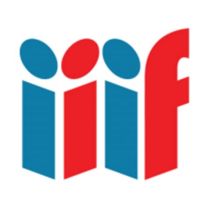
IIIF: the key to digital fragmentology!
All that tech-speak may be a little jarring, but it really is the key to the what fragmentology can accomplish. Let’s unpack it.
IIIF (the International Image Interoperability Framework) is a way of presenting digital images in an online environment that allows them to be shared via a permanent URL instead of by downloading and uploading into a silo (there’s more to it than that, of course, but that’s the basic idea). In other words, if an online image is IIIF-compliant, it can be manifested in a workspace known as a “shared canvas” simply by pointing to the permanent IIIF URL. The image is drawn into the shared canvas when called for rather than being physically stored there. This interoperability has the advantage of enabling a user to apply their own metadata and annotations and sequence the images without transforming the actual imagefile. An image can be stored in one place while being used in multiple workspaces. The model is completely open-access and avoids siloing, and is thus in keeping with digital best practices. Even the code needed to set up a IIIF server is open-source. For more on IIIF and shared canvas, including technical specifications (which are WAY beyond my ken), see the IIIF site.
So what does all this have to do with digital fragmentology? To find out, we have to go to Switzerland.
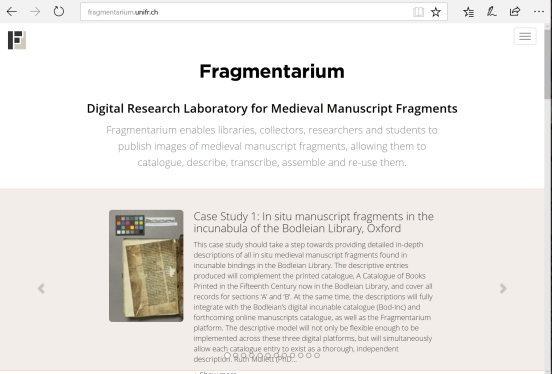
The recently-launched Fragmentarium project (based in Fribourg) combines IIIF with a powerful mySQL database to allow for the cataloguing of individual fragments and leaves and the virtual reconstruction of parent manuscripts in a shared canvas workspace. Brought to you by the incredible team behind e-codices, Fragmentarium uses a flexible and well-designed data model that is fragment-centric and follows international standards of authority and data modeling. It is the culmination of decades of development on the technical side and of metadata design on the scholarly side. Several institutions are already working on Fragmentarium case studies, uploading images (if they don’t already have IIIF purls), cataloguing them, and creating virtual reconstructions.
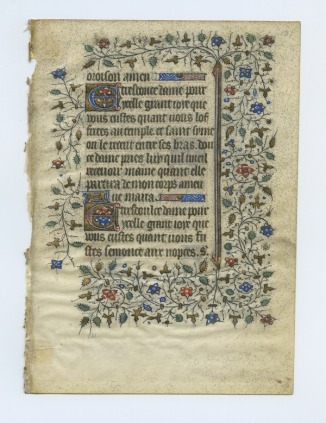
A leaf of FOL 30 (Special Collections and University Archives, University of Massachusetts Amherst Libraries, Fifty Original Leaves from Medieval Manuscripts, no. 30)
Let’s head back to Boston now, to the Simmons School of Library and Information Science, where I teach an annual course titled “The Medieval Manuscript from Charlemagne to Gutenberg.” For the last three years, I have assigned my students an Ege manuscript to study and reconstruct as their final project. You can read about the 2015 and 2016 projects here. This year, my students participated in a Fragmentarium case study. Each student was assigned a leaf from the lovely early fifteenth-century Book of Hours known as “Fifty Original Leaves no. 30” (or FOL 30), because leaves from this manuscript are always no. 30 in Ege’s Fifty Original Leaves from Medieval Manuscripts portfolios. We found twenty-eight leaves in twenty-eight collections, and the first part of the assignment was for each student to catalogue their leaf in the Fragmentarium database. I am extremely grateful, by the way, to Fragmentarium’s William Duba and Christoph Flüeler for facilitating the project.

Simmons students creating the shared canvas sequence
Once the leaves had been catalogued, we worked as a class to assemble the known leaves in order in a IIIF shared canvas. Fragmentarium makes sequencing images simple with a drag-and-drop feature. Once the images are in order, one click creates the shared canvas reconstruction (click the “thumbnails” link at the bottom and the “metadata” link at the left for the full experience). The students were familiar with the basic structure of a Book of Hours, so once they had identified the contents of each leaf, it was fairly straightforward to put the leaves in order and create a record for the reconstructed manuscript (this work was made even easier by the survival of folio numbers on some of the leaves!).
The next step demonstrated why such reconstructions are worthwhile. Using the cumulative liturgical evidence of the reconstructed manuscript – much more evidence than survives on a single leaf – the students conducted original research to determine its origin and provenance. By analyzing the saints in the reconstructed Litany and the liturgy of the Office of the Dead, the students concluded that the manuscript was originally written for the Use of Paris (no other portions of the manuscript that might have provided supporting evidence – such as the Calendar or the Hours of the Virgin – survive). By searching the dimensions and known contents of the reconstructed manuscript in the Schoenberg Database, they were able to identify several early-twentieth-century sales of the whole manuscript and identify it as the manuscript purchased by collector C. L. Ricketts from dealer Bernard Quaritch in 1922 (see de Ricci, Census I:634, no. 116) and sold by Parke-Bernet Galleries in 1939. It was dismembered by Ege or his business partner Philip Duschnes soon thereafter. As a final step, I updated the Schoenberg Database to reflect these discoveries, creating a new manuscript record that links the provenance records. These discoveries by my students were completely original. Instead of considering these a scattered group of pretty leaves, we now know that this manuscript was made for the Use of Paris and, from details in the Parke-Bernet catalogue, we know it had 189 leaves and seven miniatures and that it had been bound by Rivière. We know it was offered by Quaritch several times before being bought by Ricketts in 1922. We know it was bought and broken sometime after 1939. And now we can see, at least in part, how it once looked.
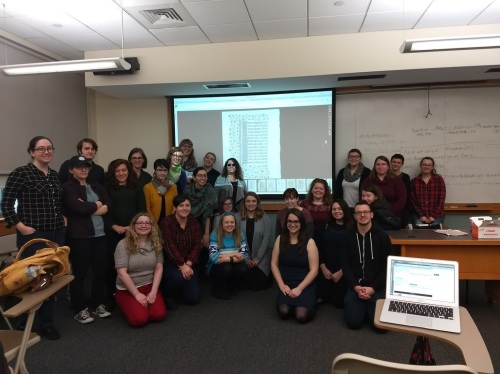
When I remember sitting on my living room floor with scissors and paste, I am truly awed and inspired by the beauty, simplicity, and effectiveness of the Fragmentarium model. Next year, my students will use Fragmentarium to reconstruct and study FOL 29. Who knows what we’ll find? Stay tuned.
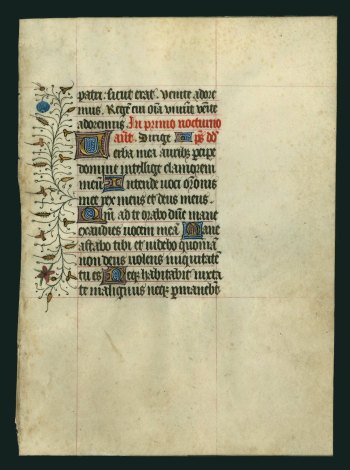
A leaf of “Fifty Original Leaves” no. 29 (Special Collections, Archives & Preservation, University of Colorado Boulder, Ege 29)
And I really do think it’s time for Gottschalk to go digital.

Lisa It would be brilliant to see a video of the Fragmentarium project at work, showing just how the program and data base work together and are used for a specific task. It’s all the ‘buzz’ at the moment.
You mean a screencapture video demo? I can definitely work on something (although not this week, since it’s the MAA Annual Meeting…)
It works. I had a look at the Fragmentarium site and the latest additions. One looked familiar and matched 3 leaves I had out at the time (it probably isn’t always this easy).
I think Harvard University, Houghton Library, MS Typ 959 – http://fragmentarium.ms/overview/F-2wsc
is a match for our Elliott MS 2/1-3
https://n2t.durham.ac.uk/ark:/32150/t2m6q182k16v.html
which makes a case for identifying the Harvard leaf as coming from a Gradual formerly at Bradford Academy
https://sdbm.library.upenn.edu/entries/33781
This is amazing!!! Have you contacted Bill Stoneman at Houghton with this news? He will be thrilled!
Could you send me an email with the dimensions of the Durham leaves? Thank you! lfd@themedievalacademy.org
The price-codes on Elliot MS 2/2 and 2/3 show it to have been bought by Maggs Bros. in August 1981, and Elliott 2/3 appears in their Bulletin No. 11 (November 1982), no. 52 and pl. XV, with the Bradford Academy provenance noted (priced £300, as inscribed on the leaf).
Pingback: Fragmentarium: a Model for Digital Fragmentology | Manuscript Road Trip | ZKS FOUNDATION BLOG
Pingback: Manuscript Road Trip: (Re)introducing the Gottschalk Antiphonal! | Manuscript Road Trip
Pingback: Manuscript Road Trip: Fragmentology in the Wild | Manuscript Road Trip